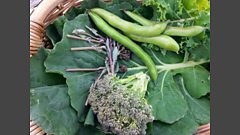
16/07/2015
Pennie Latin visits Ard Daraich, a home in Ardnamurchan, where the residents battle against the weather and a distinct lack of soil in order to grow their own fruit and vegetables.
Pennie Latin and the kitchen garden team head West and climb aboard the ferry bound for the Ardnamurchan peninsula. The first stop is Ard Daraich in Ardgour, where thrashing winds batter the landscape regularly and the sun barely peeps over the hills in winter; not your typical spot for a fruitful kitchen garden you're thinking? Well, this episode will prove you wrong. Pennie Latin meets Anna and Norrie MacLaren. Not only do they battle the extreme weather but also rocks and a distinct lack of soil in their 8 acre hill garden.
If that's not enough, this garden has even more intrigue. Famous florist and cookbook author Constance Spry once owned this house as her holiday home. New owner Anna pays homage in making her rhubarb and ginger compote. Dan Holland heads to Acharacle to meet Jill Gosney. Jill has encountered boggy ground, acidic soil and salty, scorching winds; yet still she maintains a garden with over 300 species of plants.
Last on
Clip
-
![]()
Ard Daraich, Ardnamurchan.
Duration: 00:44
Kitchen Garden Plot Blog - The diary of a grow your own enthusiast

We have blight on the allotments…Whispers sweep around the allotment of the initiating plot(s), but no one knows for sure.�� All I can say is I will not be put up against the wall and shot as I am – thankfully - clear at the moment.�� But these are perfect conditions for that dreaded plague that everyone fears – mild, (certainly not hot here in the Highlands) and damp. ��It has to be said that I did consider using ‘blight resistance’ potatoes but one of my good friends used such a strain and he’s got blight only on that crop; his others are blight free. ��So it looks as if my suspicion that claims of blight resistance being difficult to sustain is correct. ��I will continue being vigilant and keep spraying. ��For those who don’t know what blight looks like; you will find a picture in the gallery.
��
So, what to do for those that have it.�� Well, if it has just started, I would suggest the first thing you do is remove all infected leaves carefully (so that you don’t contaminate any others), and put them in a bag to be taken away and burnt or disposed of well away from your garden or allotment. Some people do compost the leaves but I wouldn't risk it.�� Spray with Bordeaux mixture and cross your fingers. ��If it starts to get a stronger hold and the pace of infection seems to accelerate, then the only real solution is to cut the leaves/shaws down to the ground to prevent any infection getting into the potatoes themselves. ��Again, there are divided opinions over what to do with the potatoes. ��Lift them or leave them?����So long as I feel confident that the disease has got into the ground, I leave mine in situ as they will continue to swell if kept watered
��
Enough of this depressing stuff! ��Everything else is in fine fettle and my harvest continues apace. ��I have a glut of calabrese so I’m freezing some for a later time. ��The tomatoes continue to fruit so feeding is a must now to ensure a full bodied and flavoursome harvest. ��I don’t have soft fruits on my allotment but there are many plots that do. ��Another friend of mine has some nice currant and gooseberry bushes that have been attacked by sawfly larvae. ��Whilst he has been away for a couple of weeks, I continued spraying his bushes with soapy water and that seems to have done the trick. Sometimes the simplest of things works wonders. ��It’s easy to tell if you have an attack of the little critters – the leaves on your plants start to disappear very rapidly and the fruit is left untouched.
��
Right now I really love going down to the allotments when we've had a lovely warm and still day.�� The route to the sweet pea section is a joy of scent.���� I've grown some old heavily scented varieties amongst the newer more spectacular (but less scented) types and I've not been disappointed. ��Soon, the gladioli will be flowering and that should be a spectacular sight as I have planted quite a lot this year! ��Oh, and finally, those broad beans lightly fried in butter for a couple of minutes are truly delicious!
Broadcast
- Thu 16 Jul 2015 13:30������̳ Radio Scotland



